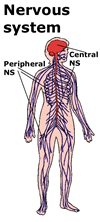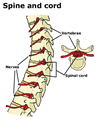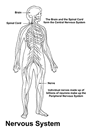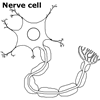 The
function of the nervous system in all animals is internal communication
and co-ordination. It co-ordinates transmission of messages to facilitate
rapid responses to changes both within the organism and in its surrounding
environment, thus greatly enhancing survival.
The
function of the nervous system in all animals is internal communication
and co-ordination. It co-ordinates transmission of messages to facilitate
rapid responses to changes both within the organism and in its surrounding
environment, thus greatly enhancing survival.
The human nervous system consists of two parts, the central nervous system
and the peripheral nervous system. Both are made entirely of nerve cells.
Central nervous system (CNS)
The central nervous system consists of the brain and the spinal cord.
|
The brain
|
|
Spinal cord
 The spinal cord, extending from the base of the brain, is protected by
the spinal vertebrae. The spinal cord facilitates transmission of information
to and from the rest of the body, like a super highway. It connects with
nerves all over the body through spinal nerves.
The spinal cord, extending from the base of the brain, is protected by
the spinal vertebrae. The spinal cord facilitates transmission of information
to and from the rest of the body, like a super highway. It connects with
nerves all over the body through spinal nerves.
Peripheral nervous system
(PNS)
 The peripheral nervous system is a network of nerves carrying messages
between the CNS and the rest of the body. It consists of cranial nerves
which are connected directly to the brain and are found in the face area,
and spinal nerves which connect the spinal cord to all other body parts.
For a finger or an arm to move, a message must originate in the brain,
travel down the spinal cord and through the spinal nerves to the muscle
which then responds by moving.
The peripheral nervous system is a network of nerves carrying messages
between the CNS and the rest of the body. It consists of cranial nerves
which are connected directly to the brain and are found in the face area,
and spinal nerves which connect the spinal cord to all other body parts.
For a finger or an arm to move, a message must originate in the brain,
travel down the spinal cord and through the spinal nerves to the muscle
which then responds by moving.
Neurons (nerve cells - also
called neurones)
 Nerves are made of neurons, arranged like wires in a telephone cable.
Nerves are made of neurons, arranged like wires in a telephone cable.
The neuron consists of a cell body with projections from
it called axons and dendrites. A neuron's structure reflects its function.
The numerous branched dendrites receive messages from adjacent neurons
or sensory organs. The long axon transmits an electrical impulse to an
effector (a muscle or gland) or to another neuron. The insulating myelin
sheath around the axon speeds up electrical transmission.

|
Nerve cell |
At the synapse (the fluid-filled gap between neurons), the electrical impulse causes chemicals called neuro-transmitters to be released into the gap. These generate another electrical impulse in the next neuron, and so the message travels. Some psychological disorders involve an imbalance in these chemicals, preventing normal message transmission.
Sensory neurones carry signals from sense receptors (eg. heat receptors in our skin) to the CNS.
Motor neurones carry signals the other way from the brain and spinal cord to effectors (muscles or glands) to cause a response (the muscle contracts or gland releases secretion).
| Copyright owned by the State of Victoria (Department of Education and Early Childhood Development). Used with Permission. |

